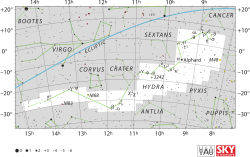Hydra (constellation)
constellation straddling the celestial equator
Hydra is a constellation that has parts in the northern sky and parts in the southern sky. It is the biggest constellation. It represents a water snake. The astronomer named Ptolemy listed Hydra when he made a list of 48 constellations.[1] It is also one of the 88 modern constellations that were made by the International Astronomical Union.
| Constellation | |
 | |
| Abbreviation | Hya |
|---|---|
| Genitive | Hydrae |
| Pronunciation |
|
| Symbolism | the sea serpent |
| Right ascension | 8–15 |
| Declination | −20 |
| Quadrant | SQ2 |
| Area | 1303 sq. deg. (1st) |
| Main stars | 17 |
| Bayer/Flamsteed stars | 75 |
| Stars with planets | 16 |
| Stars brighter than 3.00m | 2 |
| Stars within 10.00 pc (32.62 ly) | 4 |
| Brightest star | Alphard (α Hya) (1.98m) |
| Messier objects | 3 |
| Meteor showers |
|
| Bordering constellations | |
| Visible at latitudes between +54° and −83°. Best visible at 21:00 (9 p.m.) during the month of April. | |

Even though Hydra is a very big constellation, it only has one bright star. This star is named Alphard. Alphard means "the solitary one" in Arabic. Hydra actually has little to identify it exept for a cluster of stars at its head.
References
change- ↑ Ridpath, Ian. "Chapter One Continued". Star Tales. Retrieved 4 Feb 2013.